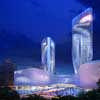Dujiangyan House, Hongkou Residential Building, New Chinese Property, Image
Hongkou Residential Development
House in Dujiangyan area, China – design by Cartwright Pickard Architects
13 Oct 2009
House in Hongkou
Case-study: Cartwright Pickard Demonstration NovoHouse
Design: Cartwright Pickard Architects
House in Hongkou
Location: Hongkou, Dujiangyan area, China
The Dujiangyan region, surrounding the city of ChengDu, is largely agricultural, with two-storey houses typically for four to five people. The most influential geographic factor is that the province is in China’s earthquake region, lies on the Longmenshan fault. The Great Sichuan Quake of 12 May 2008, registered 7.9 on the Richter scale, and has been described as the 19th most deadly earthquake of all time. Over 90,000 people were killed or reported missing, and millions left homeless after buildings collapsed. The Government has since pledged to spend 1 trillion yuan (about $146.5 billion) over the next three years to rebuild areas ravaged by the earthquake.
The area is mountainous with a humid subtropical climate, reaching 29°C in Summer and down to a minimum of 3°C in Winter. High levels of annual rainfall of 1240mm, contribute to the humidity.
A total of up to 40 demonstration houses are planned for the Dujiangyan region in collaboration with Living Steel, the Dujiangyan Municipal Government, the International Zinc Association and Baosteel. Cartwright Pickard are the only UK architects involved in this project. Three of their NovoHouse concepts are being built.
The Cartwright Pickard NovoHouse in Hongkou Village addresses the climatic and geographic requirements of the area and will provide replacement dwellings for two farming families whose homes were damaged in the earthquake. The new home is designed to be earthquake resistant, and will be built on a platform (approximately 3m x 3m) laid directly on the ground, which should also help modulate temperature fluctuations inside the house. An outdoor space provision is a local preference, and as Hongkou is a popular area of natural beauty, design includes guest rooms that the families can rent to tourists to create an additional income.
Dujiangyan area has one of the lowest levels of sunshine in China, which is exacerbated by industrial pollution. The HongKou design therefore ensures as much light as possible enters the building, and the roof options ensure there is no overhang that would block light.
To ensure the houses fit in the area, vernacular materials such as concrete, timber and masonry have been used for cladding and tiles reclaimed from damaged houses are used for the roof. Further materials from earthquake-damaged houses will be re-used where possible, such as prefabricated panels for temporary homes. The units are provided with an internal bathroom, mains sewerage facilities, running water and electricity. Wells provide the primary water source and a wood burning stove is installed for heating.
World population statistics
1. Anticipated world population growth from 2010 to 2030 is 1.40 billion (from 6.91 billion to 8.31 billion) with 1.36 billion of that growth occurring in the least developed regions (from 5.67 billion to 7.03 billion). Source: United Nations Population Division, using its median variant.
2. The UN Habitat Global Report on Human Settlements 2003 found that 1 billion people were living in slums, making up 32 per cent of the global urban population. In developing regions, slum dwellers account for 43 per cent of the population, in contrast to about 6 per cent in more developed regions.
Novo House : main page on this residence in Hongkou, Dujiangyan
About Cartwright Pickard Architects
Cartwright Pickard is an award-winning practice based in the UK, founded in 1997. Cartwright Pickard Architects aim to improve the quality of life for building users and occupiers through delivering buildings with lasting architectural merit, which create and sustain value. Its first built project was a development of 30 key worker apartments in Murray Grove, East London, the first use of an innovative steel-framed modular construction technique. Since then its wide variety of projects has encompassed the residential, commercial, industrial and education sectors. The practice has a continuing programme of research and development, resulting in notable projects applying innovative methods of construction and use of materials. In 2007 it won the international Living Steel competition for sustainable housing, leading the way for current work with Living Steel. The practice continues to use its expertise in off-site construction and environmental design to create innovative buildings worldwide across many sectors. The practice’s ability to transfer their knowledge without adding risk underpins their ability to produce high quality buildings that meet the needs of clients and address wider social concerns.
About Living Steel
Living Steel, a worldwide, collaborative programme designed to stimulate innovative and responsible housing design and construction was launched in February, 2005 by the World Steel Association. The programme was developed to help address the unprecedented pressure on infrastructure, communities and the quality of people’s lives stemming from growing urban populations.
Funded through the contributions of the world’s leading steel manufacturers, the Full Members of Living Steel include ArcelorMittal, Baosteel, BlueScope Steel, CELSA Group, Corus, Erdemir, IMIDRO, Posco, Ruukki, SeverStal and Tata Steel.
House in Hongkou image / information received 131009
Location:Hongkou, Beijing, China
Beijing Architectural Walking Tours
Beijing Buildings

image : UNStudio
Living Steel ʻRestelloʼ Kolkata
Comments / photos for the House in Hongkou Architecture page welcome
House in Hongkou Building : page
Website: Architecture Walking Tours – city walks
